 |
 |
 |
 |
||||||||
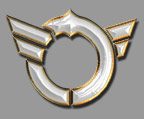 |
|||||||||||
 |
 |
||||||||||
 |
|||||||||||

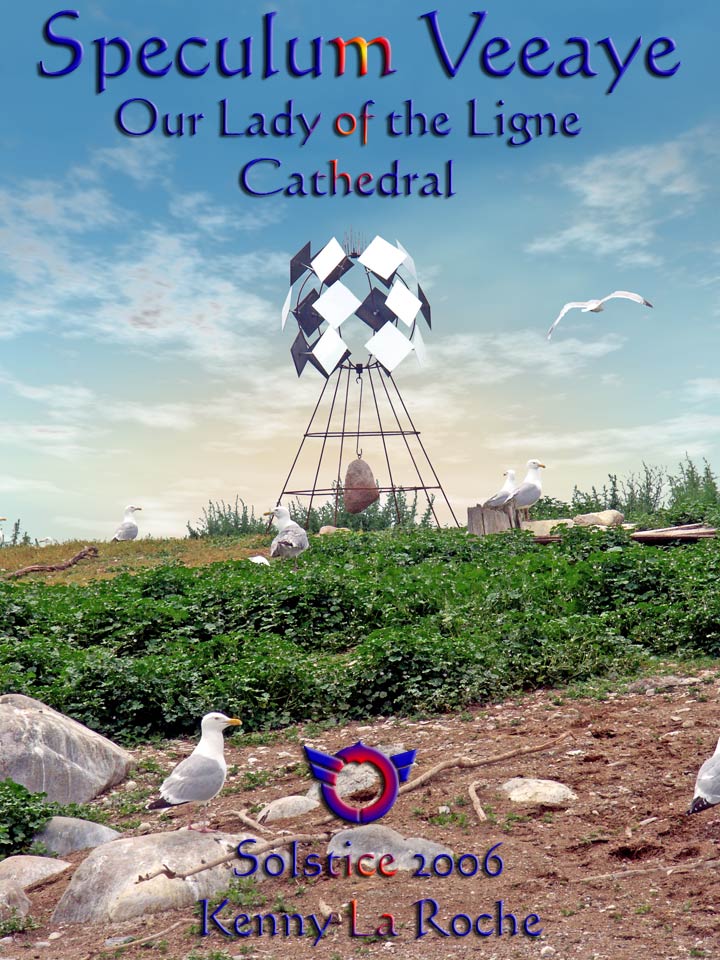
So it had taken a year to get from the Rip Wrap Morse Code idea to the finished Spike on the Îlot des Mouettes. Along the way we had abandoned our original plan with the theft of the Mulmist and had substituted for it the ambitious project of pulling down, out of the Sky Father's Sack, the remnants of his lost Shekhina. Iwojima and Skippy are both aging Altar Boys and they remember well the Holy Saturday, Easter Vigil, ceremonies and rituals which revolve around 2 ancient pre-Christian rites: the Blessing of the New Fire and the Blessing of the Baptismal Waters. In Rome, the place to be for this would be the Church of San Giovanni Laterano - the same church where every new Pope has his Tools Inventoried while he sits on the Red Marble Throne with the hole in the seat. It's a Vigil which takes place on the Saturday night before the Resurrection on Easter Sunday. "This is the day of the most intense sorrow, the day on which the Church tarries at the Lord's Tomb . . . " Everything waits in darkness for the return of the Light. An hour before Midnight there is the Blessing of the New Fire. The altar is stripped and there are no candles lighted. The Celebrant is "vested with amice, alb, cincture, purple stole and cope." Around him float other sacred Ministers, Deacons, Sub-deacons, and Altar Boys. The Year's new fire is struck from a flint and charcoal and then kindled from it. In modern times this might take a minute or two. The Altar candles are then lighted from this New Fire while the Priest blesses the flames saying: "You have bestowed on the faithful the fire of your brightness thru Your Son, Who is the cornerstone; sanctify this new fire produced from a flint that it may be profitable to us . . ." Then, in silence, he sprinkles the fire 3 times with Holy Water, while Iwojima or Skippy, all scrubbed and pure and sacred in their black and white altar clothes, takes some of the "blessed charcoal" and puts it in the Thurible - with incense and "incenses the fire 3 times."
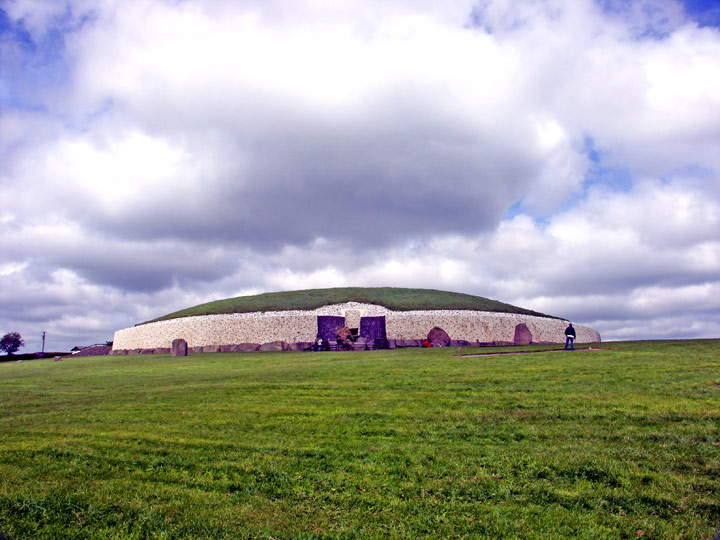
The area known as the Brú na Bóinne includes a group of about 40 prehistoric sites all within a curve of the river Boyne between Tullyallen and Slane. The largest are 3 Passage Graves called Knowth, Dowth, and Newgrange. These are high mounds which have been constructed over stone burial chambers. Locals will tell you that Bru na Boinne therefore means the "bend of the Boyne," and they are nearly right. Every site in the valley predates the Pyramids of Egypt by around a thousand years. In 3000 BC the most advanced Neolithic Civilization in Europa grew up around this bend of the river Boyne. Newgrange, the largest of the 3 Passage Graves is over 30 feet high and has an average diameter of 340 feet. Ringing the man-made hill are tons of gleaming white Quartzite which, besides girdling the front half of the monument, shine and glitter in the sparse sun of Ireland. Like the Blue Stones at Stonehenge, this Quartz had to be lugged to the Bru na Boinne from miles away. There are, today, 12 large Menhirs which form a ring of standing stones which surround the tumulous - there were once many more so there is no reason to make much of the number 12 which remain. None of these stones is decorated but there is an inner ring of 97 Kerbstones all placed on their sides and touching each other as they surround the hill and give the Quartz wall and the 20,000 tons of boulder clay which has been laid over the chambers some support. Many of these Kerbstones are heavily carved with "chevrons, spirals, wavy lines" and other abstract symbols. Legend says that the ancient Celtic Kings of Tara were buried here, but Newgrange predates any Celtic influence by a couple thousand years. There are a hundred arguments concerning the place names of the site - many of the Etics stress the Cistercian history of the area and the fact that all Cistercian farms were called "Granges." People want simple answers and stop all thinking as soon as they get them. Others, including Skippy and Pooler, will point out that "An Uamh Greine" in Celtic means "The Cave of the Sun," and that if you say that outloud for 5,000 years it will come out "Newgrange." There is no historical reason at all why the site would be called a New Grange when there is no record of an Old Grange or any separation of the Granges around into Old, New, Middle or Late. In the photo below you can see the entrance or passage way into the mound. It too is sighted exactly facing the South-East as are several of the Passage Tombs in the Valley of the Boyne.
 |
If your Objective Correlatives are throbbing they have a reason. This is the "entrance" into Newgrange. Etics call it a Light Box and I'll accept that - on the surface at least - since that is, in fact, the top opening's function. On Winter Solstice, exactly at sunrise - which in Ireland, at Newgrange - is 8:58am on the dot - the first shaft of light from the Reborn Sun pierces the Light Box and slowly crawls back 62 feet to the end of the entrance tunnel and stops - for just a minute - on a stone carved with Triple Spirals. The shaft of light lingers in the tunnel for 18 minutes and at 9:16 am it is gone and the darkness returns. The entrance is pegged to face the South-East and this piercing shaft of light will only enter the Lightbox at Winter Solstice. It is obvious then, that besides a burial tomb, the mound also functioned as a Clock, a Calendar, an Astronomical observatory. The rear of the chamber, where the sun comes to rest on the stone with 3 Spirals, is cruciform and contains 3 recesses used for burial. The corbeled roof of the burial chamber is 20 feet high and many of its large stones are carved with elaborate and evocative abstract figures with many spirals. Most of the Etics agree with all of these "facts" but from here on in there is no agreement. What is incredible about such a huge man-made structure, in a complex of many large man-made structures, is how their histories could have simply vanished from the face of the earth. If you don't have an Alphabet, History will slide right by you with hardly a notice and the only footprints left will be what people have stashed in your names.
|
|||||||||||||||
| It's odd how much the Quartz Face of Newgrange resembles the Rip Wrap along the banks of the country road which started this Spike. Both have at least one similar function: they control erosion and are structural, acting as counterweight to girdle and hold backfill. But too many Etics stop here and either miss or ignore the other "functions" which man-made constructions can have. Kenny can piss thru his dick but that doesn't mean that's what it's for. | 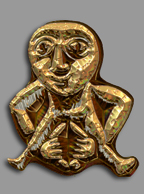 |
Yes, it's a burial mound. We found the bones. Yes it's Astronomical. We have seen the alignments. But you can mark a Solstice or any other day of the year with 2 or 3 sticks in the ground. Why would you construct a Mountain which took decades to build, when you can get the same function in a half-day's work with 3 sticks? The builders did not need Newgrange to tell time and note the Solstice, just because it accomplishes that does not mean you have found its purpose.
|
||||||||||||||
| The Rizzoli Site Plan to the left is a large rendering of a Utopian City that Rizzoli was slowly creating in his spare time. Utopias are Heavens on Earth; they are Perfect Spaces created by people living imperfect lives. Utopian Art is about Control. Obsessives and Autistics frequently construct entire alternate realities. Blake said: "I must create a Cosmology of my own or be a slave in an other man's." So moody artistic temperament and psychosis are on the same continuum. After 1935, Rizz gave up fiction and turned to very large Pen and Ink Renderings of Architectural designs. He called the symbolic representation of his buildings: "TRANSFIGURATIONS." The Y.T.T.E. Plot Plan covers an area of several square miles and consists of a symbolic city laid out in a symbolic pattern and containing symbolic buildings which are Spiritualizations/Transfigurations of the people and the events in his own life. The Kathredal is there as are: The Temple of Dreams, the Chamber of Literature, the Pen of Bestiality, the Avenue of Silver Lanterns, the Verdant Bowl of Blossoms, the Bridal Bar, the Busy Human Beehive, the Fountain of Maidens, and La Casa Del Mysteria. There are separate Temples of Welcome, Peace, to the Court of the Seasons, to Architecture, and to the Beauty of Phallism. There are 60 large buildings and 15 "Major Statuary Compositions," on this, his 4th Plot for his Jerusalem. By the 5th Plot Plan the site had grown to 80 Buildings and 20 areas of Statues. Rizz worked alone at home after work, on weekends, on holidays - by the end of his life he had full renderings - of multiple elevations - on most of the structures in his Utopia. Y.T.T.E. means: "Yield To Total Elation." It was modeled on the 1915 Panama-Pacific Exposition in San Francisco which blew Rizz's mind and gave him metaphors forever. | 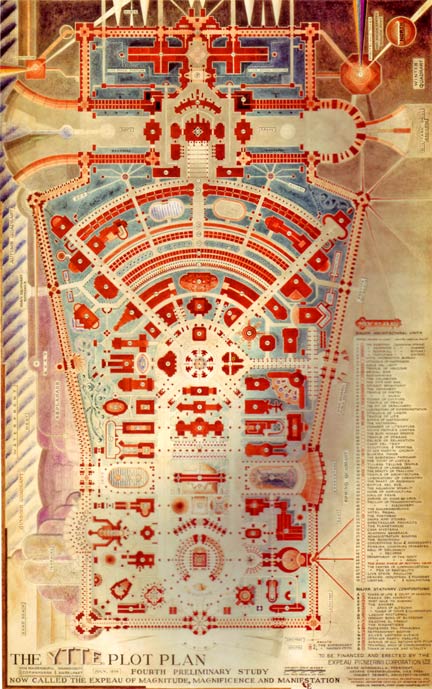 |
|||||||||||||||
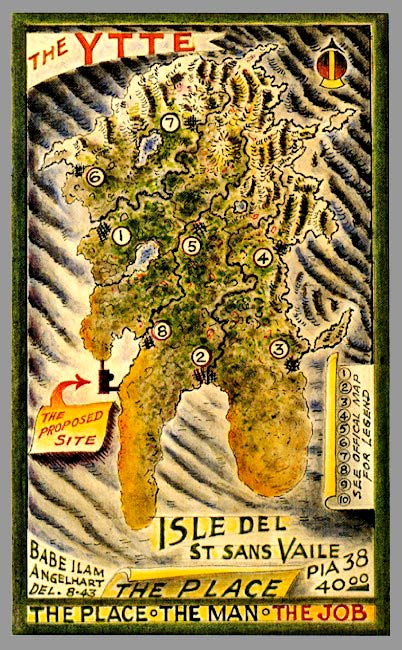 |
To house the YTTE site, Rizzoli created an Island - the wonderfully named "Isle del Sans Vaile," which was a Glossolaliac way of saying: the Island without a Veil, or the Naked Island, or at least an island which is not hiding its intentions. Don't beat yourself up if you see a large limp dick and a scrotal sack. He may as well have written "Testiculos Habet et Bene Pendentes!" across the top. Achilles Rizzoli was also obsessed with Sex - a subject he knew very little about. He never had a date, he never got a kiss. He was a Virgin for all his 85 years. If you look at where he placed his YTTE Site you can see that the constructed site would have had at least one metaphoric function: it would keep the Dick from ever getting Stiff. Eccentricity and Insanity - High-functioners will tell you both end in "ity" which is how YTTE is pronounced - but that's only one function of their similarities. Rizzoli was an underpaid draughtsman in his waking life; in his dream he was a Prince in a New World Order and like everyone who creates a Religion from the Bricolage of his Sitz-em-leben, his world was a Mirror Image of the Shekhina of the man. His Faith was Himself turned inside-out. As was the Faith of the Jews, and of Jesus, and of Elvis. Faith is a Distillation of Spirits and gives us a Liquor custom brewed to make us all "gott bedrunken mensch." Intoxicated by our own Image. The reason Faith works so well is that it fits so well. What does it mean when we try on god's boots and they fit? Because of the 1906 Earthquake/Fire, architecture was a High Art around the Bay area and Rizzoli wanted in to the Priesthood. But he never did well in school except for mechanical drawing classes. So he never went to college. He instead stayed home. And there he created a COSMOS - a Greek word whose root first described the way a woman brought order to her face. | |||||||||||||||
| After the Blessing of the New Fire on Holy Saturday Evening - just moments before Midnight and Easter - at what is Typologically the Darkest Moment of the Year - not the Solar calendrical year - that Dark Moment comes just before 8:58am Newgrange time - but the Christian Liturgical Year which is a distillation of the life of Christ. After the New Fire is blessed it is then used to light the Paschal Candle. This is the most special candle in a Christian Church. On Maundy Thursday, the day of the Last Supper, all Christian churches are darkened when all of the lights, lamps, votives, and altar candles are snuffed. Then the night before the Resurrection the New Fire is kindled from ancient implements only and that fire is used to light the Paschal Candle which is often anywhere from large to huge. Salisbury Cathedral used a 36 foot tall Paschal Candle. The Paschal is the first candle of the Reborn Light so it is used to ceremoniously light all the other candles in the Temenos. Five grains of red incense are embedded in the candle at places which represent the 5 Wounds of the Crucified Christ. The Paschal Candle is only used for special ceremonies thru the year: baptism, weddings, and funerals. Sometimes they are lighted for Masses for the Dead. Since it is large and Phallic and represents fire it is usually kept not on the Altar, but next to the female baptismal font with its water. When the Celebrant lights the Paschal Candle with the New Fire he says: "May the light of the gloriously risen Christ scatter darkness of minds and hearts." | 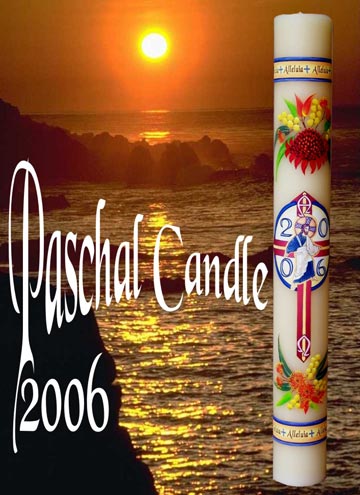 |
|||||||||||||||
 |
||||||||||||||||
| There is a widespread legend of the Middle-East that when Jesus, the Christ, finally slumped his head and died on the cross - that at that exact moment a great voice was heard all over the world and each heard the voice in his own tongue and that the voice said: "Pan is Dead. The Great God Pan is Dead!" |
"Lumen Christi!"
"Deo Gratias." |
|||||||||||||||
|
"Lumen Christi!"
"Deo Gratias." |
||||||||||||||||
|
"Lumen Christi!"
"Deo Gratias." |
||||||||||||||||
| Continue to Page 16 | ||||||||||||||||